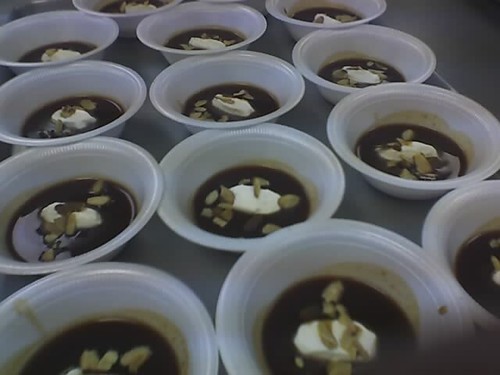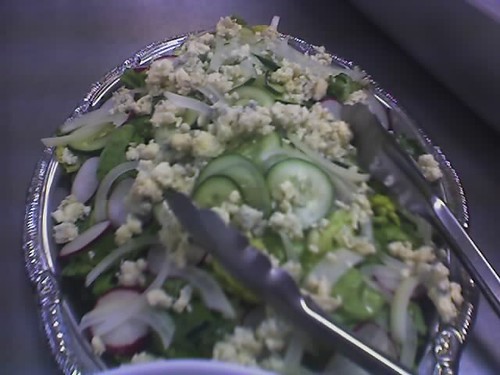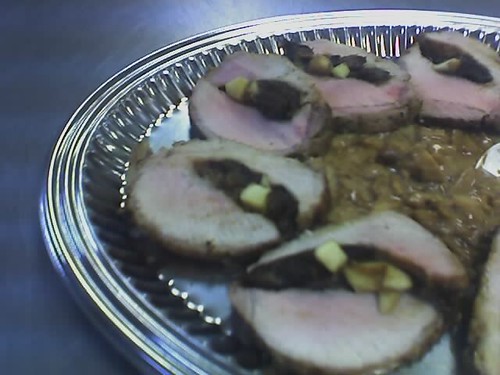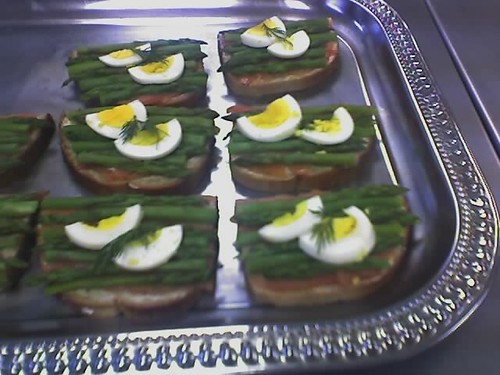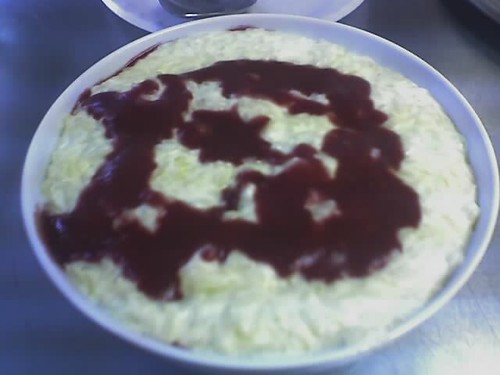Last Thursday my team and I produced our final project for Garde Manger. We had to do a theme buffet. Originally, my team thought we wanted to do a 1970s theme party with fondue and “basement party” food done well. After we all looked for recipes with no luck, we decided to go a different direction and do a Mediterranean brunch with a food tour of the Mediterranean rim, as it were.
Part of the project was to do decorations, put together ingredient lists and pull sheets (what a caterer would use to make sure all the equipment needed goes to an event site). We had some parameters we had to hit with our menu. Since garde manger covers certain production territory, we had to make a vegetable terrine, a sausage or a seafood/fish terrine, a paté, 2 hors d’oeuvres, 2 hot mains, a composed salad, a small roll or cracker, a carved fruit and cheese display and a non-alcoholic punch. Seems easy enough and the nice thing about a brunch menu is that you can play with any number of dishes that would be served as a breakfast item or a lunch or even a dinner item.
Several of the items got a dry run for the Oscar party so there is some overlap. You can give 6 cooks the same recipe and you’ll get seven different versions of the same dish and since we assigned different dishes to different groups, the things that you might have already seen a picture of don’t look exactly the same.
Our menu consisted of honeydew wrapped in proscuitto with mint and Prosecco, zucchini rolls with goat cheese, date nut muffins, roasted vegetable terrine, mixed grill-style broiled tomatoes, North African lamb sausage with herbed couscous, risotto frittata, Spanish and Italian cheese display with fresh and dried fruit, orange and red onion salad with olives, turkey/pork/pistachio/juniper berry paté wrapped in grape leaves with sweet & hot pepper jelly and a red onion and pear chutney, and an apricot fruit sparkler.
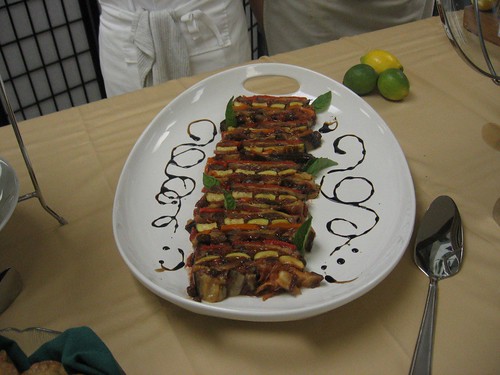
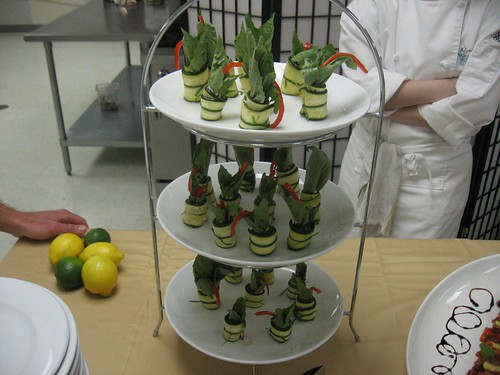

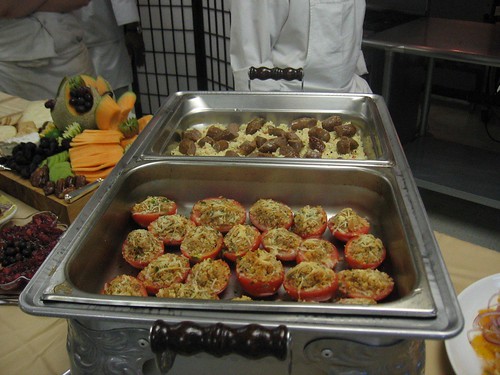
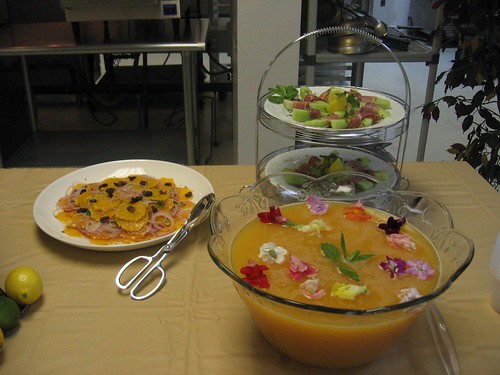

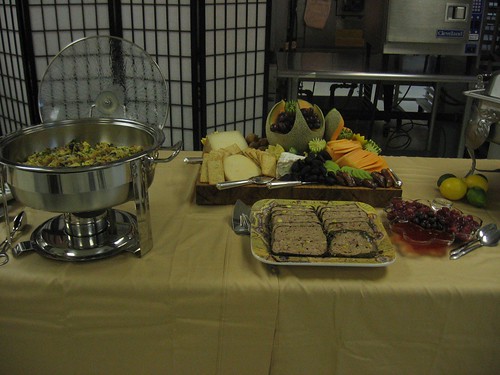
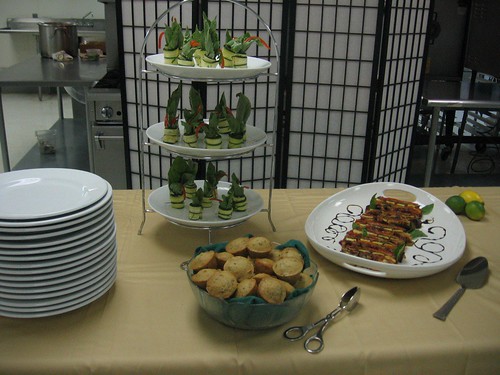
We were down three classmates, but thankfully my team mates and I had knocked out the terrine, the paté, the sausage and the jelly and chutney the day before. We had lots of down time before service and everyone seemed pretty relaxed. The week before had been a tensionfest and we had discussed not letting that happen on the day we went. I do think we managed to avoid it and I was thrilled at everyone’s work on the menu. The food looked great. The decorations were rather simple but not shoddy looking (though our table cloth really needed ironing). Over all I was pretty pleased with how everything turned out. The weird thing for me was how anti-climactic it was.
It was the last culinary anything of my two year odyssey because I only have computer courses and my internship over the summer. I guess I expected to feel done or feel something but it was just suddenly over and we were packing all the stuff into my car. I stopped for coffee on the way home and sat in the car sipping it thinking, “That’s it.” It makes me even more certain that a party of some sort needs to be had when the actual degree is being conferred. I need something that says this chapter is done and now you can get into the meat of what happens next. I need to actually find an internship before that conferring happens. That’s pretty important.
Again, if you’d like to tackle this menu on your own…
Fruit Sparkler Punch
Yield: 4-6 servings
2 cups chilled apricot nectar
2 cups chilled soda water
1 cup chilled apple juice
1 cup chilled orange juice
Combine just before serving. Serve over ice.
Melon with Prosciutto, Mint and Prosecco
Yield: 2 servings
1 medium honeydew melon
6-8 mint leaves
2 oz. lean prosciutto, sliced very thinly
Freshly ground black pepper, for garnish
Splash prosecco
1. Peel and seed melon. Cut the flesh lengthwise into 3/4” thick slices.
2. Chiffonade the mint leaving a few whole leaves for garnish.
3. Wrap a piece of prosciutto around the middle of each melon wedge.
4. Arrange wedges on one large plate or two smaller serving plates. Garnish with mint and black pepper.
5. Drizzle the Prosecco over the melon, approximately 2 tablespoons.
Rolled Zucchini Ribbons with Basil, Chili Pepper and Goat Cheese
Yield: 20 rolls
4-5 small zucchini
3 Tbsp extra-virgin olive oil
Salt and Pepper to taste
2 thumb-sized red chili peppers, deseeded and thinly sliced
Small bunch fresh chives
4 oz. mild goat cheese
Handful fresh basil leaves
2 small handfuls baby arugula, long stems removed
Toothpicks to secure
1. Cut the zucchini into 20 ¼” thick slices lengthwise. Brush with 2 tablespoons of the olive oil and season with salt and pepper. Put under the broiler, cooking on both sides until caramelized. Do not over cook or they will be too soft to roll. Set aside to cool.
2. Heat remaining oil in a heavy sauté. Add the chili peppers and fry until crisp around the edges. Drain on paper towels.
3. Bring a small saucepan of water to the boil, drop in the chives and remove immediately with a slotted spoon. Shock in cold water and remove to paper towels to dry.
4. Spread each zucchini slice with about 1 teaspoon of goat cheese. Place a couple of basil leaves, 2-3 chili pepper slivers, and some arugula across one end so they protrude (all on the same side—this will stick up when the roll is finished and set on its side). Gently roll the slice up and secure with a toothpick. Tie a chive around the roll and trim the ends with scissors. Remove toothpicks and refrigerate until serving.
Roasted Vegetable Terrine with Vinaigrette
Serves 6
2 large red bell peppers, quartered, cored and seeded
2 large yellow peppers, quartered, cored and seeded
1 large eggplant, sliced lengthwise
2 large zucchini, sliced lengthwise
6 Tablespoons olive oil
1 large red onion, thinly sliced
½ cup raisins
1 Tablespoon tomato paste
1 Tablespoon red wine vinegar
1 2/3 cup tomato juice
2 Tablespoons powdered gelatin
fresh basil leaves, garnish
For the dressing:
6 Tablespoons extra virgin olive oil
2 Tablespoons red wine vinegar
salt and pepper to taste
1. Place prepared peppers skin side up under a hot broiler and cook until skins are blackened. Transfer to a bowl and cover with plastic wrap. Let cool.
2. Arrange the eggplant and zucchini slices on separate baking sheets. Brush them with olive oil and roast in a hot oven, turning if needed, until they are tender and golden.
3. Heat remaining olive oil in a frying pan, and add the sliced onions, raisins, tomato purée and red wine vinegar. Cook gently until the mixture is soft and syrupy. Set aside and let cool in the pan.
4. Line a 7 ½-cup terrine with plastic wrap, leaving a little hanging over the sides of the container.
5. Pour half the tomato juice into a saucepan, and sprinkle with the gelatin. Allow to bloom, then dissolve gently over low heat, stirring to prevent lumps.
6. Place a layer of red peppers in the bottom of the terrine, and pour in enough of the tomato juice with the gelatin to cover.
7. Continue layering the vegetables, pouring tomato juice over each layer. Finish with a layer of red peppers. Add the remaining tomato juice to the pan, and pour into the terrine. Give it a sharp tap, to disperse the juice. Cover and chill until set.
8. To make the dressing, whisk together oil and vinegar and season. Turn out the terrine and remove the plastic wrap. Serve in thick slices, drizzled with dressing and garnished with basil leaves.
Turkey, Juniper and Peppercorn Terrine
Serves 10-12
8 oz. chicken livers, trimmed
1 pound ground turkey
1 pound ground pork
8 oz. pancetta, diced small
½ cup shelled pistachios, roughly chopped
1 teaspoon salt
½ teaspoon ground mace
2 garlic cloves, crushed
1 teaspoon drained green peppercorns in brine
1 teaspoon juniper berries
½ cup dry white wine
2 Tablespoons gin
finely grated zest of one orange
8 large vacuum-packed grape leaves in brine
oil, for the terrine
1. Chop the chicken livers finely. Reserve about ¼ of the pancetta and pistachios. Put the chopped livers in a bowl and add the turkey, pork, pancetta, pistachios, salt, mace and garlic. Mix well.
2. Lightly crush the peppercorns and juniper berries and add them to the mixture. Stir in the white wine, gin and orange zest. Cover and chill overnight to let the flavors mingle.
3. Preheat the oven to 325°F. Rinse the grape leaves under cold running water. Drain them thoroughly. Lightly oil a 5-cup pâté terrine or loaf pan. Line the terrine or pan with the leaves, letting the ends hang over the sides. Pack half of the mixture into the terrine or pan, sprinkle over the reserved pancetta and pistachios, and pack in the remaining meat mixture. Fold the leaves over to enclose the filling. Brush lightly with oil.
4. Cover the terrine with its lid or with aluminum foil. Place it in a roasting pan and pour in the boiling water to come halfway up the sides of the terrine. Bake for 1 and 3/4 hours, checking the level of the water occasionally, so that the roasting pan does not dry out.
5. Let the terrine cool, then pour off the surface juices. Cover with plastic wrap, then aluminum foil and place weights on top. Chill in the refrigerator overnight. Serve at room temperature with chutney and red pepper jelly.
Dried Cherry, Pearl Onion and Pear Chutney
Yield: approximately 3 Cups
½ # red pearl onions
2 Bartlett pears, peeled, cored, cut into 1/4” dice
Juice of one lemon
1 ¼ Cups dried cherries
¾ Cup red wine vinegar
½ Cup sugar
½ teaspoon kosher salt
1/8 teaspoon ground cloves
1. Boil onions for 2 minutes. Drain and cool. Carefully peel onions; trim root ends. Cut in half lengthwise. Set aside. In a large bowl, toss the pears with lemon juice.
2. Place cherries, pearl onions, half the pears, vinegar, sugar, salt, cloves and 2 cups of water in a low-sided, non-reactive saucepan. Set over high heat, cover and bring to a boil.
3. Reduce heat to medium low and simmer, uncovered, until the fruit is tender, about 45 minutes.
4. Raise heat to high; cook until the liquid has been absorbed, about 10 minutes. Stir in the remaining pears and reduce heat to low; cook just until the pears are heated through, about 5 minutes. Remove the pan from the heat.
5. Set chutney in an ice water bath to cool quickly and refrigerate for up to one week.
Hot & Sweet Red Pepper Jam
Yield: approximately 2 Cups
1 Cup coarsely chopped, seeded and deribbed sweet red peppers
1/8 Cup coarsely chopped, seeded and deribbed fresh hot red peppers
¾ Cup cider vinegar
½ teaspoon salt
3 ¼ Cup sugar
1 pouch liquid pectin (3 oz.)
Tabasco to taste
1. Chop peppers to a very coarse purée in a food processor, using some of the vinegar as a liquid. Scrape into a non-reactive pan. Add remaining vinegar and salt.
2. Bring to a boil over medium heat; lower the heat and simmer, uncovered, stirring occasionally. Remove from the heat. Measure the mixture and return 1 ½ Cups to the pan. If the mixture measures less than 1 ½ Cups add water to make up the difference. Stir in the sugar.
3. Bring to a full rolling boil that cannot be stirred down over high heat, stirring constantly, and boil for 1 minute. Remove from the heat.
4. Add pectin, mixing well. Taste jam mixture for hotness and add drops of hot pepper sauce, if desired. Skim off any foam. Cool, stirring occasionally to prevent pepper bits from floating to the top. Refrigerate for up to two weeks.
Orange and Red Onion Salad with Cumin
Yield: 6 servings
6 oranges
2 red onions
1 Tablespoon cumin seeds
1 teaspoon coarsely ground black pepper
1 Tablespoon chopped fresh mint
6 Tablespoons chopped fresh flat-leaf parsley
salt
fresh mint sprigs
niçoise olives
1. Peel and thinly slice oranges into rounds, catching any juice. Thinly slice the onions and separate into rings.
2. Arrange the orange and onion slices in layers in a shallow dish, sprinkling each layer with cumin seeds, black pepper, mint and olive oil. Salt to taste. Pour over the collected orange juice.
3. Let the salad marinate in a cool place for about 2 hours. Just before serving, sprinkle with mint sprigs and niçoise olives.
Risotto Frittata
Serves 4
2-3 Tablespoons olive oil
1 small onion, finely chopped
1 garlic clove, crushed
1 large red bell pepper, seeded and cut into thin strips
¾ cup risotto rice
1 2/3- 2 cups simmering vegetable stock
2-3 Tablespoons butter
2 ½ cups button mushrooms, finely sliced
4 Tablespoons freshly grated Parmesan cheese
6-8 eggs
salt and ground black pepper
1. Heat 1 Tablespoon oil in a large, non-stick frying pan and sauté the onion and garlic over low heat until the onion begins to soften but does not brown. Add the pepper and cook, stirring, until soft.
2. Stir in the rice and cook gently, stirring constantly, until the grains are evenly coated with oil.
3. Add a quarter of the vegetable stock and season with salt and pepper. Stir over low heat until the stock is absorbed. Continue adding more stock, a little at a time, letting the rice absorb the liquid before the next edition. Continue cooking the rice in this way until it is al dente.
4. In a separate small pan, heat a little of the remaining oil and some of the butter and quickly fry the mushrooms until golden. Transfer to a plate.
5. When the rice is tender, remove from the heat and stir in the cooked mushrooms and the Parmesan cheese.
6. Beat together the eggs with 8 teaspoons of cold water and season well. Heat the remaining oil and butter and add the risotto mixture. Spread the mixture out in the pan, then immediately add the beaten egg, tilting the pan so that the omelet cooks evenly. Fry over medium high heat for 1-2 minutes, finish under the broiler if necessary. Transfer to a warmed plate and serve immediately.
Mixed Grill-Style Broiled Tomatoes
Serves 4
1 cup fresh white bread crumbs
4 large, firm but ripe plum (Roma) tomatoes
¼ cup freshly grated Parmesan cheese
3 Tablespoons unsalted butter, melted
1 ½ teaspoons finely chopped chives
1 ½ teaspoons finely chopped fresh flat-leaf (Italian) parsley
1 teaspoon finely chopped fresh tarragon
1 egg, lightly beaten
salt and freshly ground black pepper
1. Preheat the broiler.
2. On a baking sheet large enough to spread the bread crumbs out in a thin layer, toast them until they are a golden brown. Set aside.
3. Core the tomatoes and cut them in half through their stem ends. Using a fingertip or the handle of small spoon, remove their seeds and the pulp between the seed sacs.
4. Add the Parmesan cheese, butter, chives, parsley, tarragon and egg to the tasted crumbs and stir to mix well. Season to taste with salt and pepper and mix well again.
5. Spoon the bread crumbs mixture into the tomato halves, dividing it evenly and mounding it slightly. Lightly grease a baking dish large enough to hold the tomatoes in a single layer and place the stuffed tomato halves in it, stuffing side up. Slip the dish under the broiler 8-10” from the heat source and broil until the tomatoes are hot and the stuffing is nicely browned, 5-7 minutes. Remove from the broiler and serve hot.
North African Lamb Sausage
Yield: approximately 5 pounds of sausage
4 pounds boneless lamb shoulder, diced
1 pound pork back fat, diced
1 ½ oz. kosher salt (3 Tablespoons)
2 teaspoons sugar
1 teaspoon hot red pepper flakes
2 Tablespoons minced garlic
1 ½ cups roasted red peppers
1 ½ teaspoons freshly ground black pepper
2 Tablespoons Spanish paprika
2 Tablespoons minced fresh oregano
¼ cup dry red wine, chilled
¼ cup ice water
20 feet sheep casings, soaked in tepid water for at least 30 minutes and rinsed
1. Combine all the ingredients except the wine and water and toss to distribute the seasonings. Chill until ready to grind.
2. Grind the mixture through the small die into a bowl set in ice.
3. Add the wine and water to the meat mixture and mix with the paddle attachment (or a sturdy spoon) until the liquids are incorporated and the mixture has developed uniform sticky appearance, about 1 minute on medium speed.
4. Cook a small portion of the sausage, taste and adjust the seasonings if necessary.
5. Stuff the sausage into the sheep casings and twist into 10” links. Refrigerate or freeze until ready to cook.
6. Gently sauté or roast the sausage to an internal temperature of 150°F. Serve with sautéed peppers and steamed couscous.
Date Nut Muffins
Yield: 12 muffins
8 fl. oz. water
6 oz. chopped pitted dates
4 oz. sugar
4 oz. unsalted butter
½ teaspoon vanilla extract
2 eggs
10 oz. all-purpose flour
2 teaspoons baking powder
¼ teaspoon baking soda
¼ teaspoon salt
1 ½ oz. chopped pecans
1. Preheat a non-convection oven to 375°F. Butter a 12-cup standard muffin pan.
2. In a small saucepan over medium high heat, bring the water to a boil. Stir in the dates, sugar and butter, remove from the heat and let stand until the dates have absorbed most or all of the liquid and have cooled to lukewarm (approximately 15 minutes).
3. Transfer the dates and any remaining liquid to a mixing bowl. Add the vanilla. One at a time, add the eggs, beating well after each addition until thoroughly incorporated. In another bowl, stir together the flour, baking powder, baking soda and salt. Add the date mixture and the nuts and stir until well combined.
4. Spoon the batter into the prepared muffin-pan cups, filling each about ¾ full. Bake until the muffins are well risen and a toothpick inserted into the center of one comes out clean, approximately 20 minutes.
5. Remove from the oven and let cool for 5 minutes in the pan, then remove the muffins from the pan. Serve warm or at room temperature.
Spanish and Italian Cheese and Fruit Board
Yield: serves 6-8
6 oz. Manchego
6 oz. Taleggio
8 oz. Bel Paese
4 oz. dried calmyra figs
4 oz. dried mission figs
1 fresh pomegranate
1 small ripe melon, cantaloupe or honeydew
2 bunches black or red grapes
1 carambola (star fruit)
various carved fruit (lemon, orange, kiwi) flowers for decoration
Recipe Research Sources
Ingram, Christine. Best-Ever Appetizers, Starters & First Courses. Hermes
House: London. 2003.
Joyce, Jennifer. Small Bites: tapas, sushi, mezze, antipasti, and other finger
foods. DK Publishing, Inc.: New York. 2005.
Ruhlman, Michael and Brain Polcyn. Charcuterie: the craft of salting, smoking and
curing. W.W. Norton & Company: New York. 2005
Williams-Sonoma Kitchen Library. Breakfasts & Brunches. Weldon Owen Inc.:
San Francisco. 1998.
Witty, Helen. Fancy Pantry. Workman Publishing Company, Inc.: New York. 1986.
Witty, Helen. The Good Stuff Cookbook. Workman Publishing Company, Inc.:
New York. 1997.


















